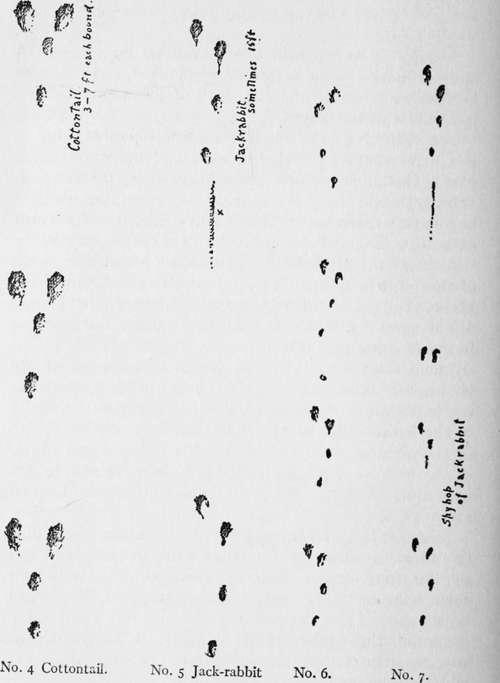Rabbits And Hares
Description
This section is from the book "The Book Of Woodcraft", by Ernest Thompson Seton. Also available from Amazon: The Book of Woodcraft.
Rabbits And Hares
America is well provided with rabbits and hares. A score or more of species are now recognized, and two very well-known types are the cottontail of the woods and the jack-rabbit of the plains.
The cottontail is much like an English rabbit, but it is a little smaller, has shorter ears, and the whole under part of the tail is glorified into a fluffy, snowy powder-puff. It leads the life of a hare, not making burrows, but entering burrows at times under the stress of danger. The track of a New England cottontail is given in Illustration 4.
As the cottontail bounds, the hind feet track ahead of the front feet, and the faster he goes the faster ahead his hind feet get. This is true of all quadrupeds that bound, but is more obvious in the rabbits, because the fore and hind feet differ so much in size.
The jack-rabbit of Kansas is the best known of the long-eared jacks. His trail, compared with that of the cottontail, would be as in Illustrations 5 and 6.
The greater size of the marks and the double length of the bounds are the obvious but not important differences, because a young jack would come down to the cottontail standard. The two reliable differences I found are:
First, the jack's feet are rarely paired when he is bounding at full speed, while the cottontail pairs his hind feet but not his front ones. (Animals which climb usually pair their front feet in running, just as tree-birds hop when on the ground).
Second, the stroke that is shown (x in Illustration 5) is diagnostic of the southern jack-rabbit; it is the mark made by the long hanging tail.
Each of the four types of hare common in the temperate parts of America has its own style of tail and fashion of wearing it:

The northern or white-tailed jack carries his snowy-white tail out straight behind, so its general pure-white is visible;
The southern or black-tailed jack has his tail jet-black on the upper part, and he carries it straight down;
The varying hare has an inconsequent, upturned tuft, like a tear in his brown pantaloons, showing the white undergarment;
The cottontail has his latter end brown above, but he keeps it curled up tight on his back, so as to show nothing but the gleaming white puff of cotton on a helpful background of rich brown. The cottontail's tail never touches the ground except when he sits down on it.
The most variable features of any animal are always its most specialized features. The jack-rabbit's tail-piece is much subject to variation, and the length and depth of the little intertrack-ial dash that it makes in the snow is a better guide to the individual that made it than would be the tracks of all four feet together.
Continue to:
- prev: Wolf
- Table of Contents
- next: The Newton Jack Rabbit
Tags
bookdome.com, books, online, free, old, antique, new, read, browse, download
